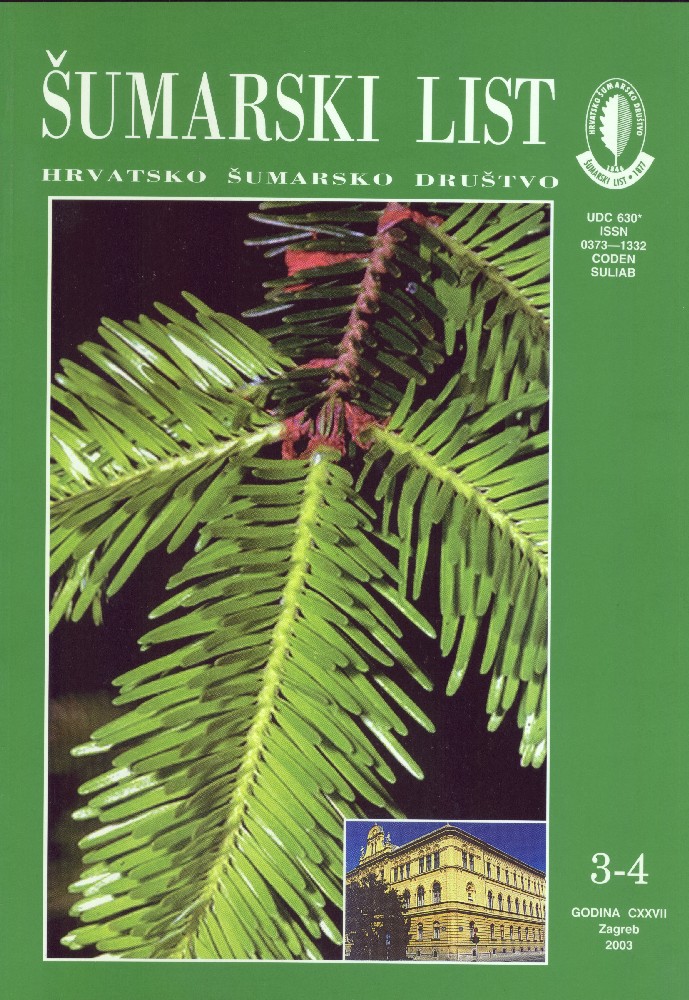
broj: 3-4/2003
pdf (28,3 MB) |
|
||||||||||||||
| IZVORNI ZNANSTVENI ČLANCI | ||
| Margaletić, J., Glavaš, M., Pavić, K. | UDK 630* 451 (001) | |
| The Numerousness of Small Rodents and their Harmfulness in the Management Unit of “Južna Krndija I (Kutjevačka)” and in the Nursery “Hajderovac”. pdf HR EN | 99 | |
| Križanec, R. | UDK 630* 612 + 613 (001) | |
| New Variants of Time Management of Selection Forests pdf HR EN | 109 | |
| Ballian, D. | UDK 630* 165 (001) | |
| Estimate of the Genetic Variability of Silver Fir (Abies alba Mill.) by Analysis of Isoenzymes in the Part of Natural Populations of Bosnia and Hercegovina and Croatia pdf HR EN | 135 | |
| PREGLEDNI ČLANCI | ||
| Vojniković, S. | UDK 630* 188 | |
| The History and Recent Problems of the Phytocoenological Nomenclature and Classification pdf HR EN | 153 | |
| Summary: The selecting, nomination and classification of the new associations are very complex and claim task. Plant community is not visible bounded unit, and we can not define them with morphological form. About 800 forest associations were described and determined in ex Yugoslavia but we can estimate existing of about 340 forest associations that have specific fioristic composition and structure in particular ecological conditions. They are usually either synonyms for local variants or fades, which were selected and classified in association s rank. The problem of harmonising of synonyms related to republics of ex Yugoslavia as well as neighbour country´s. It is estimated that even 1/3 of determined phytocoenoses were described before in other countries but under different names. The essential idea related to dividing vegetation on plant communities appeared on beginning of XIX century from brilliant plant geographysts: Humbolt (1805). Schouw (1823), Heer (1835) and Greisbach (1835)´. The idea was developed into the two main directions: the physiognomic and the floristic. Based on the work of their students was born the idea for floristic- sociological approach. On the begging of XX century this idea leaded on Braun-Blanquet and his colleges from Zurich and Montpellier was more developed. On the Third International Botanical Congress in Brussels Flahault & Schroter (1910) presented first definition of the association. Braun- Blanquet 1921 established the base for the system as a whole, with analytical scales and the "sociologicalprogression ". The unique definition for association with following rules was accepted 1976 in Den Haag and 1980 in Sydney on Botanical Congresses. In the paper was mentioned that last changing of the international Codex was at 2000 year by the We b e r, H. E.; Moravec, J.; Theurillat, J. -P. The most frequent failures concerning nomenclature and classification are as follows: non-accepting rules for nomenclature (Codex of Phytocoenological Nomenclature): non-following actual phytocoenological systematic; different interpreting terms and definitions and poor researching and lack of knowledge related to plant community. The problem of characteristic species was mentioned in this paper. The characteristic plants were compared with main mineral of stones. The mineral can belong to a number of different assemblies of main minerals. Consequently, characteristic specie can belong to different plant communities, which are defined with assembly of characteristics species. Some important questions should be focused (related to an assembly of characteristic species not only one plant) as follows: What are the differences between assemblies? Which species appeared? Which species disappeared? Some mistakes and problems in classification and phytocoenolgical nomenclature in the region were discussed in the paper. The strict using phytocoenolgical nomenclature could result with some problems for foresters on the field. The reasons are as follows: foresters are usually not expert in phytocoenology, they have insufficient floristically knowledge and some species appear in one aspect only, e.g. spring or summer. We have to be very careful regarding naming some new plant community. In order to solve these problems we need detail analyses phytocoenological classifications and we have to compare situation in widerphytogeographical areas, with an ultimate aim of renaming sintaxomy categories in accordance with Codex of Phytocoenological Nomenclature. | ||
| STRUČNI ČLANCI | ||
| Margaletić, M. | UDK 630* 931 + 891 | |
| The Exploitation of Mineral Raw Materials in Relation to the Forest and Forest Land pdf HR EN | 161 | |
| Nodilo, J. | UDK 630* 432 | |
| Fire in the Open Space of the Islands and Littoral - Accident or a Logical Sequence of Events pdf HR EN | 171 | |


